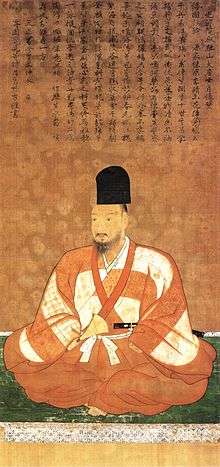Ashikaga Yoshiteru

Ashikaga Yoshiteru (足利 義輝, March 31, 1536 – June 17, 1565), also known as Yoshifushi or Yoshifuji, was the 13th shōgun of the Ashikaga shogunate who reigned from 1546 to 1565 during the late Muromachi period of Japan. He was the eldest son of the 12th shōgun, Ashikaga Yoshiharu; and his mother was a daughter of Konoe Hisamichi (later called 慶寿院 Keijuin). When he became shogun in 1546 at age 11, Yoshiteru's name was Yoshifushi (sometimes translitrated as Yoshifuji);[1] but some years later in 1554, he changed his name to the one by which he is conventionally known today.[2] His childhood name was Kikubemaru (菊童丸). His younger brother Ashikaga Yoshiaki became the fifteenth shōgun.
Family
- Father: Ashikaga Yoshiharu
- Mother: Keijuin (1514–1565)
- Wife: daughter of Konoe Taneie
- Concubines:
- Kojiju no Tsubone
- Karasumaru-dono
- Children:
- Teruwakamaru (1562-1562)
- nun in Kyokoji temple
- nun in Kyokoji temple
- Ashikaga Yoshitaka
- Oike Yoshitatsu by Karasumaru-dono
Installed as shōgun
After his father, Yoshiharu, was forced to retire in 1546 over a political struggle with Hosokawa Harumoto, Yoshiteru became Sei-i Taishōgun, albeit a puppet shōgun like his father. Yoshiteru was only 11 at the time and his investiture ceremony was held at Sakamoto, Ōmi Province, outside Kyoto.
Yoshiteru had barely been confirmed as shōgun when his father Yoshiharu made a truce with Harumoto to return to Kyoto. Yet, Harumoto's retainer Miyoshi Nagayoshi parted with Harumoto to take the side of Hosokawa Ujitsuna and the two Hosokawa started a war that drove out Yoshiteru, his father Yoshiharu, and Harumoto as well, from Kyoto. In 1550, Yoshiharu died in Ōmi, unable to return to Kyoto.
In 1552, Yoshiteru made a peace with Nagayoshi to return to Kyoto. However, the next year, Yoshiteru and Harumoto started a war against Nagayoshi to remove his influence. With the help of Rokkaku Yoshikata, the war initially went well for Yoshiteru but he was driven out of Kyoto again in 1558 with a counterattack from Nagayoshi. Nagayoshi did not press on after the victory to kill Yoshiteru for fear of being accused of killing a shogun, and instead signed a truce to have Yoshiteru back in Kyoto under his influence. Nagayoshi continued as the real power in Kyoto, with Yoshiteru nothing more than a rubber stamp.
Timeline
Significant events shaped the period during which Yoshiteru was shōgun:[3]
- 1550 – Yoshiharu dies in exile; Yoshiteru's "shogunate" in exile begins.[3]
- 1551 – Sue Harukata rebels against Ōuchi Yoshitaka.[3]
- 1552 – Yoshiteru returns to Kyoto, actual power being held by Miyoshi Nagayoshi and Matsunaga Hisahide.[3]
- 1554–1564 – Ōuchi's retainer Mōri Motonari succeeds him and consolidates his power.[3]
- 1557 – Ōgimachi succeeds.[3]
- 1558 – Nagayoshi drives out Yoshiteru who, however, is reinstated.[3]
- 1560 – Oda Nobunaga slays Imagawa Yoshimoto.[3]
- 1564 – Uesugi Kenshin and Takeda Shingen reach a stalemate at Kawanakajima after continuous battles, checking each other's power. (1553–1564).[3]
- 1565 – Matsunaga Danjo Hisahide invades Kyoto; Yoshiteru commits suicide.[3]
Governance

Surrounded by daimyōs who intended only to use the authority of shogun for their own good, Yoshiteru still managed to reaffirm the shōgun's authority by active diplomacy that extended to every part of Japan. By trying to negotiate a peace between such well-known daimyōs as Takeda Shingen and Uesugi Kenshin, Shimazu Takahisa, Ōtomo Yoshishige, Mōri Motonari, and Amago Haruhisa, the shogun's authority was again recognized by various daimyōs. Lacking resources, Yoshiteru nevertheless saw opportunities to assign his kanji "輝" on various samurai such as Mōri Terumoto to become something close to a godfather. Yoshiteru was well respected for his actions and many researchers credit him as being the last effective shōgun to hold the post. Oda Nobunaga and Uesugi Kenshin were among the many daimyōs and samurai who travelled to Kyoto to pay their respects to the shōgun.
End of reign
In 1564, Nagayoshi died of illness and Yoshiteru saw an opportunity to fully reclaim the shōgun's authority. However, Matsunaga Danjo Hisahide and the three member council of Miyoshi, the Miyoshi Triumvirs, who wanted to rule just as Nagayoshi had, were willing to go to any lengths to remove Yoshiteru from the power and to have Ashikaga Yoshihide as the puppet shōgun.
In 1565, Matsunaga Danjo Hisahide and Miyoshi Yoshitsugu laid siege against a collection of buildings (that would later become Nijō Castle) where Yoshiteru lived. With no help arriving in time from the daimyōs that could have supported him, Yoshiteru and the few troops under him were overrun by Miyoshi.
Jesuit missionary Father Luís Fróis, in his account of the overthrow of Ashikaga Yoshiteru, wrote about the strong sexual love relationship between Yoshiteru and his squire, Odachidono. Such homosexual love relationships were very common in the world of samurais, where relationships between knights and their squires were infused with an idealism in which romance and valour in battle were closely linked. According to Father Fróis, the shōgun's squire, Odachidono, "fought so valiantly and with such intrepid spirit that all the rebels started to shout out that he should not be killed, but that he should be taken alive. Nonetheless, seeing his master die, and believing it a great dishonour to survive him, the youth threw away his sword, and pulling out his dagger, he cut open his throat and then his belly. Finally he killed himself by lying down flat with the dagger in his belly."[4]
Three years passed before his cousin Ashikaga Yoshihide became the fourteenth shōgun.
Legacy
Because of his inner strength and the katana skills that he was known to have practiced regularly, Yoshiteru was called the "Kengo shōgun" (剣豪将軍) and was closer to being a samurai and a warlord than any shōgun since Ashikaga Takauji. One of his sword-fighting instructors was Tsukahara Bokuden, the founder of Kashima Shintō-ryū.[5] His governance was highly credited but to have been killed in spite of his efforts completely destroyed what little recognition and authority Yoshiteru built up.
The waka Yoshiteru was said to have left on his death shows the extent of his aspirations compared with the limits of achievements.
| Kanji | Rōmaji | English |
|---|---|---|
| 五月雨は 露か涙か 不如帰 我が名をあげよ 雲の上まで |
samidare wa tsuyu ka namida ka hototogisu waga na o ageyo kumo no ue made |
The May rain falls, and is it my tears or the mist that surround me? Hototogisu,[6] take my name and soar above the clouds |
Eras of Yoshiteru's bakufu
There were more than one era name or nengō in which Yoshiteru was identified as Shogun .[7]
Notes
- ↑ Ackroyd, Joyce. (1982). Lessons from History: the Tokushi Yoron, p. 298.
- ↑ Titsingh, Isaac. (1834). Annales des empereurs du japon, p. 381., p. 381, at Google Books
- 1 2 3 4 5 6 7 8 9 10 Ackroyd, p. 332.
- ↑ Neill, James (2009). The Origins and Role of Same-Sex Relations in Human Societies. USA: McFarland & Company, Inc., Publishers. p. 279. ISBN 978-0-7864-3513-5.
- ↑ Ichiro Watanabe, Tsukahara Bokuden in Shogakukan, Encyclopedia Nipponica. (in Japanese)
- ↑ Hototogisu is the lesser cuckoo (Cuculus poliocephalus). Written in kanji it means never to return
- ↑ Titsingh, p. 372–389., p. 372, at Google Books
References
- Ackroyd, Joyce. (1982) Lessons from History: The Tokushi Yoron. Brisbane: University of Queensland Press. ISBN 9780702214851; OCLC 7574544
- Titsingh, Isaac. (1834). Nihon Ōdai Ichiran; ou, Annales des empereurs du Japon. Paris: Royal Asiatic Society, Oriental Translation Fund of Great Britain and Ireland. OCLC 585069
External links
- Momoyama, Japanese Art in the Age of Grandeur, an exhibition catalog from The Metropolitan Museum of Art (fully available online as PDF), which contains material on Ashikaga Yoshiteru
| Preceded by Ashikaga Yoshiharu |
Shōgun: Ashikaga Yoshiteru 1546–1565 |
Succeeded by Ashikaga Yoshihide |
